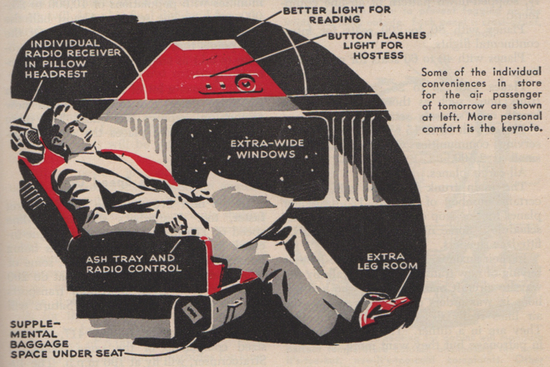An illustration of air travel in the future from the September 1946 issue of Popular Science [Source: Novak Archive]

Before the American airline industry had really taken off, there were many predictions about what pent-up consumer demand following WWII would mean. The September 1946 issue of Popular Science imagined what air travel might look like just five years into the future. The cover proclaimed that “Air Travel for Everybody” was just over the horizon!
Cover of the September 1946 issue of Popular Science magazine [Source: Novak Archive]From Popular Science:

By 1951, air transports and the airline pattern itself, both domestic and intercontinental, will confound the most extravagant predictions of the men who were nursing a few scrawny air lines to maturity in 1931.
The article made historical comparisons to the railroads, as it was the intercontinental railroad reaching further and further west that opened up the United States and built the backbone of the country we know today.
But for all the planning that is under way, the growth and character of air-line service are bound to be somewhat hodgepodge for the next few years. The carriers themselves are guessing at exactly what’s coming. They are in the midst of a tepid re-enactment of the railroads’ expansion three-quarters of a century ago. It is a tepid performance because the air lines are rigidly—some critics say too rigidly—controlled by the Government.
And that government regulation was debated from the beginning. As Derek Thompson over at The Atlantic explained recently, the price of air travel in the United States has fallen sharply since deregulation in the 1970s. Price and the efficiency of their planes was, of course, the most pressing concern of the airlines after WWII, as Popular Science noted:
One thing is certain: Faster, more efficient planes are coming. They will go farther on a gallon of gas, and that means lower fares. One manufacturer already is talking about the possibility of New York-to-San Francisco flights in less than eight hours for as little as $86. That compares with $118.30, tax extra, at present. The Pullman fare for the same trip is $127.13 (or 4.01 cents a mile); that by rail coach, $63.12; by bus, $45.25.
New York to San Francisco in eight hours for $118.30? Adjusted for inflation, that’s about $1,375 in 2013 dollars.
But while prices came down dramatically, the amenities of the average passenger have become decidedly less posh. The illustration above imagined the experience of the average airline passenger in the early 1950s. “More personal comfort” was the focus, with extra-wide windows, electronic entertainment and perhaps the amenity I miss most: extra leg room. Of course, that image isn’t at odds with what is available on long-haul flights today—if you’re willing to pay.
Photo of a “roomy table” from the airplane of the future [Source: Novak Archive]






